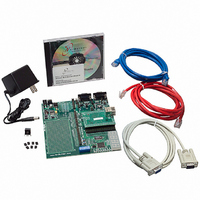NNDK-MOD5272-KIT NetBurner Inc, NNDK-MOD5272-KIT Datasheet - Page 459

NNDK-MOD5272-KIT
Manufacturer Part Number
NNDK-MOD5272-KIT
Description
KIT DEVELOP NETWORK FOR MOD5272
Manufacturer
NetBurner Inc
Series
ColdFire®r
Datasheets
1.MOD5272-100IR.pdf
(2 pages)
2.MOD5272-100IR.pdf
(550 pages)
3.NNDK-MOD5282-KIT.pdf
(2 pages)
Specifications of NNDK-MOD5272-KIT
Main Purpose
*
Embedded
*
Utilized Ic / Part
MOD5272
Primary Attributes
*
Secondary Attributes
*
Processor To Be Evaluated
MOD5272
Interface Type
RS-232, RS-485, USB
Lead Free Status / RoHS Status
Contains lead / RoHS non-compliant
Lead Free Status / RoHS Status
Lead free / RoHS Compliant, Contains lead / RoHS non-compliant
Other names
528-1001
- Current page: 459 of 550
- Download datasheet (6Mb)
MOTOROLA
20.5.1 Bus Sizing
The MCF5272 can be configured for an external physical data bus width of 16 bits by
pulling QSPI_Dout/WSEL high, or for 32 bits by pulling QSPI_Dout/WSEL low during
reset. When the external physical address bus size is configured for 16 bits, the signals
D[15:0] become general purpose I/O port C.
The MCF5272 determines the port size for each transfer from the CSBRs at the start of each
bus cycle. This allows the MCF5272 to transfer operands from 8-, 16-, or 32-bit ports. The
size of the transfer is adjusted to accommodate the port size indicated. A 32-bit port must
reside on data bus bits D[31:0], a 16-bit port must reside on data bus bits D[31:16], and an
8-bit port must reside on data bus bits D[31:24]. This requirement ensures that the
MCF5272 correctly transfers valid data to 8-, 16-, and 32-bit ports.
The bytes of operands are designated as shown in Figure 20-1. The most significant byte of
a longword operand is OP0; OP3 is the least significant byte. The two bytes of a word length
operand are OP2 (most significant) and OP3. The single byte of a byte length operand is
OP3. These designations are used in the figures and descriptions that follow.
Figure 20-2 shows the required organization of data ports on the MCF5272 for 8-, 16-, and
32 bit devices. The four bytes shown are connected through the internal data bus and data
multiplexer to the external data bus. This path is how the MCF5272 supports programmable
port sizing and operand misalignment. The data multiplexer establishes the necessary
connections for different combinations of address and data sizes.
Table 20-2. Chip Select Memory Address Decoding Priority (Continued)
31
OP0
Figure 20-1. Internal Operand Representation
OP1
Chapter 20. Bus Operation
Priority
Lowest
15
OP2
OP2
7
Chip Select 3
Chip Select 4
Chip Select 5
Chip Select 6
Chip Select 7
OP3
OP3
Chip Select
OP3
0
0
0
LONGWORD OPERAND
BYTE OPERAND
WORD OPERAND
Data Transfer Mechanism
20-5
Related parts for NNDK-MOD5272-KIT
Image
Part Number
Description
Manufacturer
Datasheet
Request
R

Part Number:
Description:
BOARD SERIAL-ETHERNET 512K FLASH
Manufacturer:
NetBurner Inc
Datasheet:

Part Number:
Description:
PROCESSOR MODULE FLASH MOD5272
Manufacturer:
NetBurner Inc
Datasheet:

Part Number:
Description:
PROCESSOR MODULE 512KB FLASH
Manufacturer:
NetBurner Inc
Datasheet:

Part Number:
Description:
DUAL PORT SERIAL-ETHERNET
Manufacturer:
NetBurner Inc
Datasheet:

Part Number:
Description:
PROCESSOR MODULE FLASH
Manufacturer:
NetBurner Inc
Datasheet:

Part Number:
Description:
PROCESSOR MODULE 512KB FLASH
Manufacturer:
NetBurner Inc
Datasheet:

Part Number:
Description:
MOD5234 10/100 ETHERNET MODULE
Manufacturer:
NetBurner Inc
Datasheet:

Part Number:
Description:
KIT DEVELOP NETWORK FOR MOD5282
Manufacturer:
NetBurner Inc
Datasheet:

Part Number:
Description:
DUAL PORT SERIAL-ETHERNET
Manufacturer:
NetBurner Inc
Datasheet:

Part Number:
Description:
Ethernet Modules & Development Tools 32 Bit 66MHz 40 Pin DIP Industrial Temp
Manufacturer:
NetBurner Inc
Datasheet:

Part Number:
Description:
Ethernet Modules & Development Tools MOD5213 DEVELOPMENT KIT
Manufacturer:
NetBurner Inc

Part Number:
Description:
Ethernet Modules & Development Tools DUAL PORT SERIAL EHTERNET DEVICE
Manufacturer:
NetBurner Inc
Datasheet:

Part Number:
Description:
Ethernet ICs 32bit 147MHz CAN-to- Ethnt Device IndTemp
Manufacturer:
NetBurner Inc
Datasheet:










